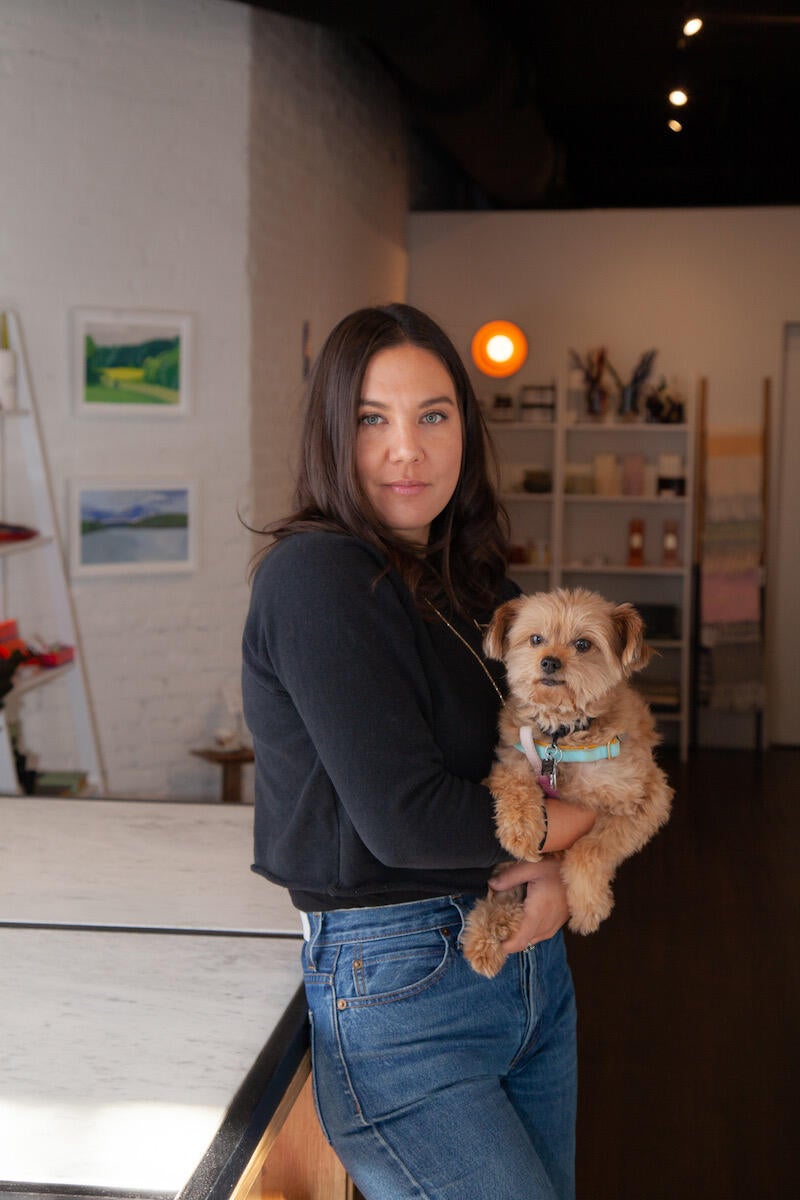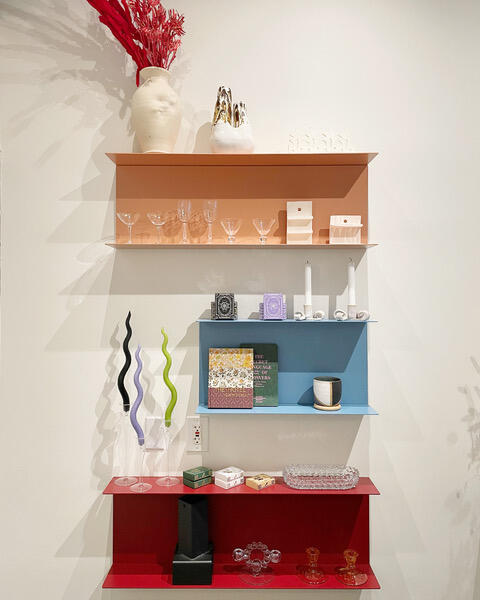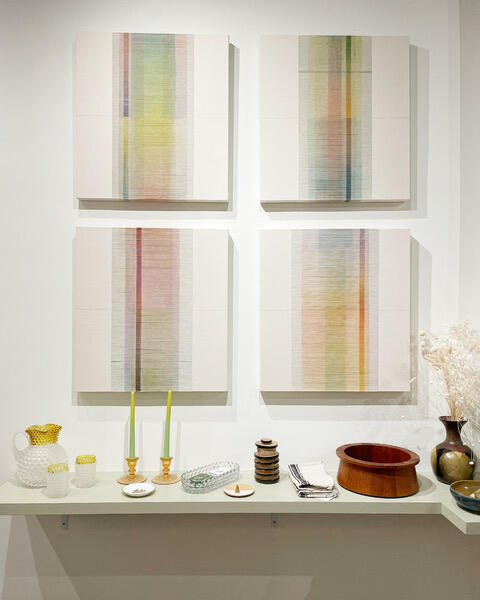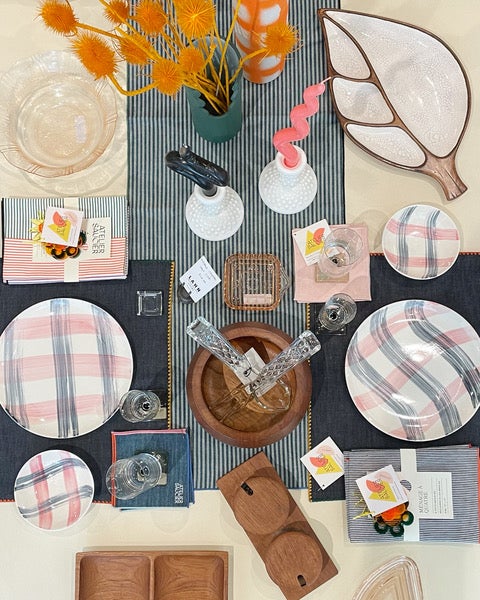In Business of Home’s series Shop Talk, we chat with owners of home furnishings stores across the country to hear about their hard-won lessons and challenges, big and small. This week, we spoke with New York–based designer and shop owner Elise Ballegeer of Lahn.

After studying apparel design at the Rhode Island School of Design, Ballegeer launched her own ready-to-wear fashion line in 2015 and had just opened the doors on a boutique in the West Village when the pandemic hit. While the timing cratered other small businesses, she managed not just to survive, but to expand into a new arena—homewares—and open another brick-and-mortar location, just around the corner, called Lahn Living. How did she manage to expand during such a perilous time, why home decor, and how in the world did she afford some of the country’s most precious commercial real estate? Here, Ballegeer explains how she got by with a little help from her very creative friends.
When in 2020 did you open the apparel shop?
I put the sign on the door February 22, 2020, and closed three weeks later.
Brutal.
Yeah, it was terrifying. As a fashion designer with my own label, I was selling to the [woman who owned the store before me]. We were friends, and she fell in love and was moving, and asked if I wanted to be co-owner. The store really promoted independent designers, and the more I thought about it, the more I was like, “We don’t really have a platform.” There are very few multibrand boutiques left that do this. So I took over the lease in December and then had no inventory, because I’d missed the buying season. I just called all my friends, and we opened with a sample sale—everybody’s leftover inventory—until I could buy [enough] to open on February 22. Then we closed [because of pandemic shutdowns], and I had no online store. I made that in two weeks, and then applied for every grant possible.
You built e-comm in two weeks?
Correct. It was very, very bootstrapped.
On January 22, financial expert Julia Nikishina, who specializes in interior design accounting, will share insider tips and proven strategies to maximize your tax deductions, so that you can keep more of what is rightfully yours. Click here to learn more and remember, workshops are free for BOH Insiders.
How did you keep the apparel line rolling? Because while the home industry boomed, fashion did not, from my understanding.
We pride ourselves on offering things that are really different. We’re not going to compete with wherever you buy your gray T-shirt. It’s for people who want something special, something that needs to be tried on, because you’re not going to be able to imagine how it fits. It’s pretty intricate, like [one of the designers we carry,] Henrik Vibskov—his pattern-making is insane. Also, with the pandemic, everybody realized how much they loved their local small businesses and wanted to invest in them. People would come around and buy a pair of socks. For the longest time, I was like, “What are we, the sock mecca?” But it totally kept us alive.
It was me and two other part-time women. I lived and breathed it, and because I had just started, I had all this energy. I’ve been self-employed since 2009, so I think I have that mentality of “Make it work, adjust, pivot, make it work.” Being able to adapt quickly is probably what saved us.
How did you go from barely hanging on with apparel to expanding to a second location, and into a different category?
It was that sweet spot [moment] in New York, when all the rents [were low] because everybody had vacated. There’s no way I could have gotten that space now. I could negotiate on rent! The rents are high in the West Village, and landlords want unique businesses that add value for their [residential] tenants. Nobody wants to live above the smoke shop or bar. They were like, “Please? We’ll make it work!”
All the pieces had to line up in a very specific way. It was the end of the summer of 2021, which was a huge boom for us in retail because [lockdowns had lifted and] everybody was back out. They were spending again. I remember walking down the street seeing women in ball gowns during the day, just because they could. There was this real reverence for being able to be out. I knew [money] was going to be really tight for the first few years, and it still is. I’m not going to lie and say that it’s easy. But every day, with the feedback, I’m like, “OK, this is working!” It was a good decision. The home stores in the West Village are Jonathan Adler and John Derian, and I felt there was a huge gap.

Did you have an interest in home before? How did you begin to go about buying?
I started essentially the same way that I started apparel. Coming from art school, I have a beautiful community of fine artists, designers, ceramicists. We joked that the store should have been called Friends of Mine, because I called everybody up and pitched them the idea: “I don’t have any money to buy, but would you want to put your stuff in the store on consignment?” That’s how we started.
I’ve always had a passion for vintage, midcentury. I used to freelance with [Sagaponack, New York–based furnishings brand] Wyeth, and would go to estate sales and source these beautiful objects. It was a great way to find unique products and bring in a lot of character. I think home goods stores can fall into [two ways of] being: vintage and tchotchke and overwhelming, or all new stuff, which can be really sterile. I was really trying to tap into the medium: How do you have really beautiful new objects communicate with the old, and do it on a shoestring budget?
It was a real slow burn. We would reach out to a lot of the [makers who] blew up on Instagram during the pandemic; [Brooklyn-based artist Dustin Barzell of] Ceramicism is a great example. He’d do editions of 11 pieces, but didn’t have representation in a brick-and-mortar. I said, “Hey, let’s do an event! We’ll throw a party, bring people in, and everyone can touch and feel these hand-made pieces.” That’s how we’ve moved since. With each season, I’m able to grow a little bit more—have steady inventory, and attend markets and trade shows.
It’s funny that you mentioned John Derian and Jonathan Adler as the two West Village design guys, because I can immediately see those aesthetics. How would you describe yours?
Probably as far away from both of those as possible. It’s contemporary art mixed with a lot of midcentury. Because of my apparel [designs], textiles also have a really important place in the store. Even our art is very textile based, in a lot of tertiary colors, which is very different from that Jonathan Adler blue or John Derian’s deep, dark, romantic vibe. It’s not pop, but it’s eclectic.
Who’s the typical customer?
Probably 50 percent of the people we get in say, “I came in because of the window. It’s so different!” Every day, people are still discovering [us, saying:] “I live around the corner.” We get a lot of interior designers, a painter, an art critic. That’s the demographic of the neighborhood.
It's funny what they gravitate toward. The older folks are a little more well-versed and educated, so they’re not going to question why this piece of furniture is at this price point. They can see the value. It’s more for the younger customer that I have the entry-level candles and fun design objects. Then [they see the larger furnishings, and] they’re like, “What’s this?” That’s the opportunity to bring them into this world of craftsmanship and quality.

What’s the product that moves the fastest?
Do you know the brand Viissiionss? They do squiggly candles, and I get to pick the color assortment every season, and it’s such a no-brainer. They’re $22, and it’s a great gift. That’s the thing that’s the hardest to keep in stock. We have regular scented candles, where [customers are] like, “I’m going to a dinner. I need to bring a gift.” I try not to carry the candles that everybody else carries, and then they have to come back.
What about your own favorite object in the store?
Right now, it’s Atelier Saucier. They do these really beautiful napkins—and as I’m saying that, it sounds funny to be so passionate about napkins! But they’re made in L.A. with dead-stock fabric, and they do artist collaborations. So it’s a high-quality napkin with an incredible print and great binding on the edge. It’s just that little twist that makes you look closer and notice the joyful aspect of it.
Are you still working with the same e-commerce system that you threw together in 2020, or has that evolved?
We are on Shopify [now], so it’s evolved for sure. Honestly, it’s a constant battle to keep up with the new features. Because the product we have is so individual, a lot of the time it’s sold before we can even get it online. It really feels like [e-commerce] needs a whole dedicated team for the ways that I would want to grow.
Do you ever worry about people “shopping” the store—looking up the brands online later and buying it for cheaper?
That’s not something we deal with too much. We keep our price points the same as our vendors’ a lot of the time. But generally, I think we win out because it’s a lot of people shopping for gifts [who need] that immediate gratification. I think we do a really good job at curating how everything goes together. You go online, and you’re like, “Wait, what was I looking for again? Do I want it in that color?” There is something to be said about that service: “These are the best options. I’ve decided for you. It’s right here, right now.”
And sometimes I feel loyalty to a shop because of that.
Yesterday, a woman came in and said, “You carry Piecework Puzzles. You’re one of the only vendors in the city that has them. I want to get one for a friend who is just getting into puzzles, and you only carry the 1,000-piece puzzles. Can I order a 500-piece puzzle through you?” My jaw dropped. She said, “I would just rather support you.” Of course I’m going to go that extra mile and order this puzzle specifically for you!

She wants you to be her puzzle dealer! Has your rent changed since opening, and what are some of the other difficulties of operating in New York or the West Village?
Rent is always going to be a challenge in New York. It’s just impossible—more than our payroll. For the Paycheck Protection Program, they really didn’t take into consideration that a lot of people’s rent in New York is higher than their payroll. I’m aware, in working with the landlord, that it’s a real give-and-take relationship. We want to make it good for both of us. [But] I can’t ever tell how it’s going to go. That is another reason why I opened the second location—I didn’t want all my eggs in one basket. The apparel store [owners] sold the building to a management company, and everybody was expecting them to double or triple the rent. Thankfully, that didn’t happen, but you just don’t know. A huge goal for me for e-comm is to have it pay my rent so that I never have to be in the situation I was in during the pandemic ever again.
In New York, everybody can find whatever they need at any time, so it is a constant battle of defining who we are and making sure that we’re different. Staffing is really important—that we have creative people who can really talk about the work. One of the photographers whose work we sell also works in the store. That creates a better environment for shopping, so that’s been a huge focus for me—ways that we can set ourselves apart. Even down to the music, we’re playing independent labels, because we have so many creative staff members who are like, “I’m part-time at this label!” They’ll make playlists, and then people ask, “Can you send this playlist to me? We’re going to follow you on Spotify.” It’s a full ecosystem of creatives, and I think that’s the best way for us to differentiate and compete with the CB2s [of the world].
How do you feel about the future of small business?
Anybody in small business knows that you’re not in it to make millions of dollars. I do it because it’s rewarding. You’re part of a community. I don’t have a five-year goal to expand or franchise or whatever. Some people start with that idea: How can I have passive income? But when I was doing my design label, I was in the studio the entire time, and I never got that immediate feedback. In the shop, the best part is getting people’s reactions.
So I think our future will [focus on] community. When we do events for small designers, [sometimes it takes the format of] a class or a pop-up dinner, so we bring in guest chefs and sell the tableware that everybody’s eating off of. Businesswise, the best opportunity for me is to grow e-comm, and have a team who can handle shipping and logistics and questions. That’s where I’m seeking growth.
You mentioned hearing customer feedback. What is your favorite day as a shop owner?
Customer interactions always win out. You feel like people get it, and that you’re doing it for a reason and it’s valued. That discovery on both ends—I love the customer being like, “Oh, my gosh, this is so cool,” and then I love to give that feedback to the designer or artist.
Actually, the Viissiionss candle? We get a lot of celebrities, obviously, [because of] the neighborhood, and they’re like, “Oh, my god, I love these. I got them for my sister too, and now my sister comes to the store.” To write directly to the vendor and be like, “Hey, just so you know, your candles are sitting in so-and-so’s home now.” Creating that is the best.
Homepage image: Ballegeer managed to survive the pandemic and open another brick-and-mortar location called Lahn Living | Courtesy of Lahn





























